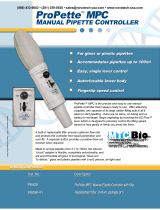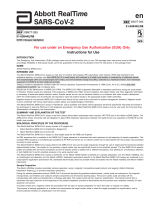Page is loading ...

Agilent Technologies
Agilent Small RNA Kit
Quick Start Guide
The complete Small RNA Kit Guide can be found in the online help of the 2100 Expert software.
Assay Principles
Agilent RNA kits contain chips and reagents designed for analysis of RNA fragments. Each RNA chip
contains an interconnected set of microchannels that is used for separation of nucleic acid fragments based
on their size as they are driven through it electrophoretically. Agilent RNA kits are designed for use with the
Agilent 2100 Bioanalyzer instrument only.
Applications and Kits
Agilent Small RNA kits are designed for the analysis of total RNA (eukaryotic and prokaryotic) and samples
enriched for small nucleic acids.
Agilent RNA kits: RNA 6000 Nano Kit (reorder-no 5067-1511), RNA 6000 Pico Kit (reorder-no 5067-1513),
and Small RNA Kit (reorder-no 5067-1548).
Storage Conditions
• Freeze unopened Small RNA ladder at -20 °C. Prepared ladder aliquots need to be stored at -70 °C. Keep
all other reagents and reagent mixes refrigerated at 4 °C when not in use to avoid poor results caused by
reagent decomposition.
• Protect marker solution (contains a fluorescent dye), dye and dye mixtures from light. Remove light
covers only when pipetting. Dye decomposes when exposed to light.
Agilent Small RNA Kit (reorder-no 5067-1548)
Agilent Small RNA Chips Agilent Small RNA Reagents (reorder-no 5067-1549) & Supplies
25 Small RNA Chips
(blue) Small RNA Dye Concentrate
1
1
“This product is provided under a license by Life Technologies Corporation to Agilent Technologies. The purchase of
this product conveys to the buyer the non-transferable right to use the purchased amount of the product and
components of the product only as described in accompanying product literature. The sale of this product is expressly
conditioned on the buyer not using the product or its components (1) in manufacturing; (2) to provide a service,
information, or data to an unaffiliated third party for payment; (3) for therapeutic, diagnostic or prophylactic purposes;
(4) to resell, sell or otherwise transfer this product or its components to any third party, or use for any use other than
use in the subfields of research and development, quality control, forensics, environmental analysis, biodefense or food
safety testing. For information on purchasing a license to this product for purposes other than described above contact
Life Technologies Corporation, Cell Analysis Business Unit, Business Development, 29851 Willow Creek Road, Eugene,
OR 97402, Tel: (541) 465-8300. Fax: (541) 335-0354”
3 Electrode Cleaners (green) Small RNA Marker (4 vials)
(white) Small RNA Conditioning Solution
Syringe Kit (red) Small RNA Gel Matrix (2 vials)
1 Syringe (yellow) Small RNA Ladder (reorder-no 5067-1550)
2 Spin Filters (reorder-no 5185-5990) + 30 tubes for gel-dye mix
Tubes for G el-Dye Mix
30 Safe-Lock Eppendorf Tubes PCR clean (DNase/RNase free) for gel-dye mix

2
Agilent Small RNA Kit Quick Start Guide
Equipment Supplied with the Agilent 2100 Bioanalyzer System
• Chip priming station (reorder-no 5065-4401)
• IKA vortex mixer
Additional Material Required (Not Supplied)
• RNaseZAP® recommended for electrode decontamination only (Ambion, Inc. cat. no. 9780)
• RNase-free water, recommended for routine electrode cleaning
• Pipettes (10 μL and 1000 μL) with compatible tips (RNase-free, no filter tips, no autoclaved tips)
• 0.5 mL and 1.5 mL microcentrifuge tubes (RNase-free Eppendorf Safe-lock PCR clean or Eppendorf DNA
LoBind microcentrifuge tubes are highly recommended)
• Microcentrifuge (> 13000g)
• Heating block or water bath for ladder/sample preparation
• Mandatory: Dedicated bayonet electrode cartridge (reorder-no 5065-4413) for RNA 6000 Pico and Small
RNA assays
• 2100 Expert SW rev B.02.05 or higher
Sample Preparation
• Prepare RNA samples in deionized water. For analysis, total RNA should be between 1 – 100ng/μL,
purified small RNA samples (< 150nt) should be 1 – 20ng/μL, and oligonucleotides should be 100 –
2000pg/μL. If concentration of a sample is above these ranges, dilute with RNase-free water.
Specifications
Setting up the Chip Priming Station
.
1
Replace the syringe:
a
Unscrew the old syringe from the lid of the chip priming station.
b
Release the old syringe from the clip. Discard the old syringe.
c
Remove the plastic cap of the new syringe and insert it into the clip.
d
Slide it into the hole of the luer lock adapter and screw it tightly to the chip priming
station.
.
2
Adjust the base plate:
a
Open the chip priming station by pulling the latch.
b
Using a screwdriver, open the screw at the underside of the base plate.
c
Lift the base plate and insert it again in position C. Retighten the screw.
Physical Specifications Analytical Specifications
Type Specification Specification Small RNA Assay
Analysis time 30 min Quantitative range 50 – 2000 pg/µL of purified miRNA in
water
Samples per chip 11 Qualitative range 50 – 2000 pg/µL of purified miRNA in
water
Sample volume 1 µL Size range 6 – 150 nt
Kit stability ≥4 months at 4 °C Sensitivity (S/N>3) 50 pg/µL in water
Kit size 25 chips
11 samples/chip
= 275 samples/kit
Quantitation reproducibility
(within a chip)
25 % CV
Quantitation accuracy -
Maximum sample buffer
strength
10 mM Tris
0.1 mM EDTA

3
Agilent Small RNA Kit Quick Start Guide
.
3
Adjust the syringe clip:
a
Release the lever of the clip and slide it down to the lowest position.
Essential Measurement Practices
• Handle and store all reagents according to the instructions on the label of the
individual box.
• Avoid sources of dust or other contaminants. Foreign matter in reagents and samples
or in the wells of the chip will interfere with assay results.
• Allow all reagents to equilibrate to room temperature for 30 min before use. Thaw the
sample on ice.
• Protect marker solution, dye and dye mixtures from light. Remove light covers
only when pipetting. The dye decomposes when exposed to light and this
reduces the signal intensity.
• Always insert the pipette tip to the bottom of the well when dispensing the
liquid. Placing the pipette at the edge of the well may lead to poor results.
.
• Always wear gloves when handling RNA and use RNase-free tips, microfuge
tubes and water.
• The gel matrix is very viscous! Proper pipetting and mixing requires special attention.
• It is recommended to heat denature all RNA samples and RNA ladder before use for 2 min at 70 °C (once)
and keep them on ice.
• Do not touch the Agilent 2100 Bioanalyzer instrument during analysis and never place it on a vibrating
surface.
• Always vortex the dye concentrate for 10 s before preparing the gel-dye mix and spin down afterwards.
• Use a new syringe and electrode cleaners with each new kit.
• Use loaded chips within 5 min after preparation. Reagents might evaporate, leading to poor results.
• To prevent contamination (e.g RNase), it is strongly recommended to use a dedicated electrode cartridge
for RNA assays.
• For cleaning of the electrode pinset inbetween runs, use RNase-free water only. Do not use RNaseZAP
unless for decontamination of the electrode pins. After using RNaseZAP, wash the pins thoroughly with
RNase-free water. Refer to the Kit Guide for details on electrode cleaning and decontamination.
Agilent Small RNA Assay Protocol
Preparing the RNA Ladder
1
Spin the ladder down.
2
Heat denature the ladder for 2 min at 70 °C.
3
Immediately cool the vial on ice.
4
Prepare aliquots in recommended 0.5 mL RNase-free vials with the required amount for typical daily use.
5
Store aliquots at -70 °C. After initial heat denaturation, the frozen aliquots should not require repeated
heat denaturation.
6
Before use, thaw ladder aliquots on ice (avoid extensive warming).
Preparing the Gel
1
Pipette the complete volume (approx. 650 μL) of the gel matrix (red ) into a spin filter.
2
Centrifuge at 10000g ± 20 % for 15 min at room temperature. Use filtered gel within 4 weeks. Store at
4°C.
WARNING
Handling DMSO
Kit components contain DMSO. Because the dye binds to nucleic acids, it should be treated as a
potential mutagen and used with appropriate care.
➔
Wear hand and eye protection and follow good laboratory practices when preparing and handling
reagents and samples.
➔
Handle solutions with particular caution as DMSO is known to facilitate the entry of organic
molecules into tissues.

Agilent Small RNA Kit Quick Start Guide
*G2938-90094*
*G2938-90094*
G2938-90094 Rev. D
Edition 01/2017
For Research Use Only
Not for use in diagnostic procedures
Printed in Germany
© Agilent Technologies, Inc. 2007-2016, 2017
Agilent Technologies
Hewlett-Packard-Straße 8
76337 Waldbronn, Germany
Preparing the Gel-Dye Mix
Loading the Gel-Dye Mix
Loading the Conditioning Solution and Marker
Loading the Ladder and Samples
Technical Support
Please visit our support web page http://www.agilent.com/genomics/contactus to find information on your
local Contact Center.
Further Information
Visit the 2100 Bioanalyzer site at http://www.agilent.com/genomics/bioanalyzer. You can find useful
information, support and current developments about the products and the technology.
1
Allow all reagents to equilibrate to room temperature for 30 min.
2
Vortex dye concentrate (blue ) for 10 s and spin down.
3
Pipette 2 µL of dye into 0.5 mL RNase-free microtubes (provided with the kit).
4
Add 40 µL of filtered gel (gel is very viscous, careful pipetting is required).
5
Mix using pipetting, or by flipping over and flicking the vial several times until the dye is
distributed equally. Visually inspect that the mix is homogeneous.
6
Spin tube at 13000g for 10 min at room temperature.
1
Put a new Small RNA chip on the chip priming station.
2
Pipette 9 µL of gel-dye mix in the well marked .
3
Make sure that the plunger is positioned at 1 mL and then close the chip
priming station.
4
Press plunger until it is held by the clip.
5
Wait for exactly 60 s then release clip.
6
Visually inspect that the plunger moves back at least to the 0.3 mL mark.
7
Wait for 5 s, then slowly pull back the plunger to the 1 mL position.
8
Open the chip priming station and pipette 9 µL of gel-dye mix in the wells
marked .
9
Discard the remaining gel-dye mix.
1
Pipette 9 µL of the RNA conditioning solution (white ) into the well
marked CS.
2
Pipette 5 µL of RNA marker (green ) in all 11 sample wells and in the well
marked .
1
Pipette 1 µL of prepared ladder in well marked .
2
Pipette 1 µL of sample in each of the 11 sample wells. Pipette 1 µL of RNA
Marker (green ) in each unused sample well.
3
Put the chip horizontally in the IKA vortexer and vortex for 1 min at
2400rpm.
4
Run the chip in the Agilent 2100 Bioanalyzer instrument within 5 min.
OJHOG\H
OJHOG\H
O51$&RQG
6ROXWLRQ
OPDUNHU
OODGGHU
OVDPSOH
/





